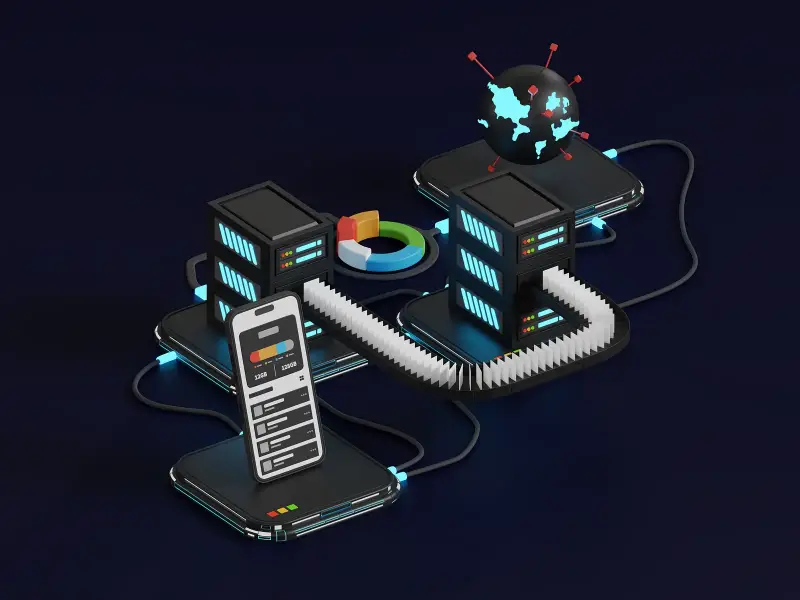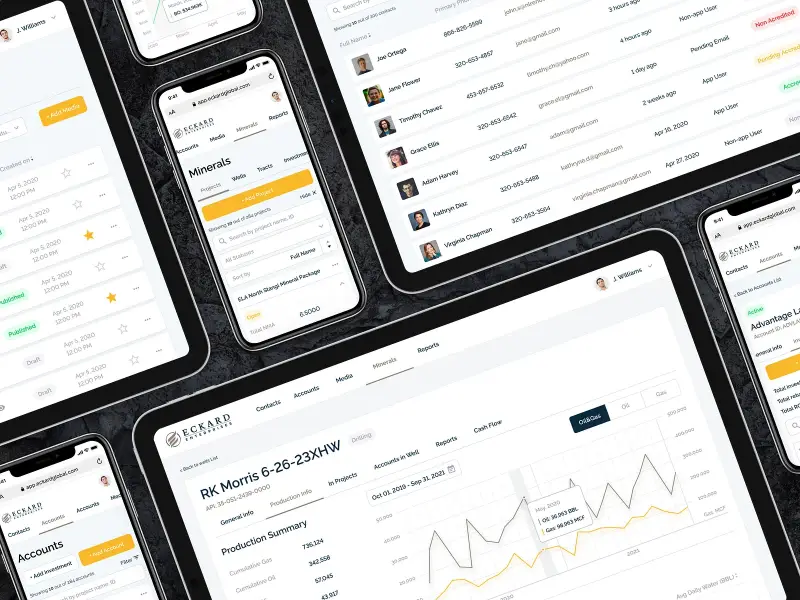Database Web Applications: Make The Right Decision
- David Ho
- 0 Comments
Picking the right solution for database web applications is a big deal. It’s one of those decisions that can shape everything—from how fast your app runs to how easily it scales as you grow. And with web traffic expected to reach 4.1 zettabytes a year by 2025, you need something that can keep up with the pressure.
Some of the top databases for web applications today include MongoDB, which is great if you need flexibility and don’t want to stick to a strict structure. PostgreSQL is a favorite for its stability and deep customization. And Redis? It’s built for speed—perfect for caching and real-time data. With the database market projected to hit over $70 billion by 2026, it’s clear this space is only getting more competitive.
As apps get more complex, it’s not just about storing data anymore. Developers need to think about performance, integrations, and how much support is out there when things go wrong. Whether you’re building a simple CRUD app or something more intense, choosing the right database early on can save you a lot of headaches later.
What Are the Types of Databases Available?
There are several types of databases in use today, each designed to meet specific needs. As technology evolves, so do the ways we store and manage data. Here’s a quick look at the most common types of databases, along with examples and a bit of background.
| Database Type | Description | Example Databases | Background |
|---|---|---|---|
| Relational | Stores data in structured tables made of rows and columns. Ideal for structured data and strong consistency. | MySQL, Oracle, Microsoft SQL Server | Introduced in the 1970s, relational databases became the standard for data storage with the rise of the SQL-based relational model. |
| NoSQL | Flexible, non-tabular databases built for large-scale, unstructured, or semi-structured data—perfect for modern web and mobile apps. | MongoDB, Cassandra, CouchDB | Emerged in the early 2000s to handle the growing scale and variety of web data beyond what traditional SQL databases could manage. |
| Document | Stores data in document formats (like JSON), allowing complex, nested data structures. Great for content-rich applications. | MongoDB, CouchDB | A subset of NoSQL, document databases gained popularity as developers needed more flexible schemas for evolving app data. |
| Key-Value | Saves data as simple key-value pairs. Extremely fast and lightweight—often used for caching and session storage. | Redis, Riak | Designed for speed and simplicity, key-value stores became essential tools in high-performance web environments. |
| Cloud | Hosted online and accessed over the internet. Offers scalability, lower maintenance, and cost efficiency compared to traditional setups. | Amazon RDS, Google Cloud SQL, Azure SQL Database | Gained traction in the late 2000s with the rise of cloud computing, offering businesses a more flexible and scalable way to manage data. |
Now that you’ve got a clearer picture of the main types used in database web applications, let’s talk about what really matters when picking one for your next web app.
Learn More On:
Things To Consider When Choosing a Database for Your Next Web App
Choosing a database isn’t just a technical step—it’s a decision that affects how your app performs, grows, and handles real-world users. With so many options out there, it helps to focus on a few key factors to find the best fit for your project.
Web based database
-
Data Structure: Think about what kind of data your app will store. If your data is nicely organized—like user accounts, orders, or inventory—a relational database might be the way to go. But if your data changes a lot, or doesn’t fit into neat tables, a NoSQL database could give you more flexibility.
-
Scalability: Will your app need to handle more users or larger datasets over time? If so, choose a database that can scale easily. A web based database offers cloud scalability, growing with your needs and minimizing setup time.
-
Performance: Your database should be able to handle requests quickly, especially if your app relies on real-time updates or fast user interactions. Some databases are built for speed—like key-value stores used for caching.
-
Ease of Use: Some databases are easier to set up and manage than others. If your team is small or still learning, look for options with a user-friendly interface, good documentation, or a managed service that handles the heavy lifting for you.
-
Integration With Other Tools: Make sure your database works well with the rest of your stack. Whether it’s your web framework, backend language, or analytics platform, smooth integration can save you a lot of time and hassle.
-
Security: If your app handles personal or sensitive data, security features like encryption, role-based access, and regular backups are a must. Some industries may also require specific compliance standards, so be sure your database checks those boxes.
-
Cost: Budget matters. Some databases are free and open source, but others charge for licenses, hosting, or advanced features. Also consider the time and resources needed to maintain it—because that’s part of the cost too.
-
Industry or Company Requirements: Depending on your field, there may be specific needs your database must meet. For example, financial or healthcare apps often have strict rules around data storage and handling.
Taking the time to weigh these factors early on can save you from major headaches later. A good database won’t just store your data—it’ll help your app run better, grow faster, and stay secure.
Have a Project Idea in Mind?
Get in touch with experts for a free consultation. We’ll help you decide on next steps, explain how the development process is organized, and provide you with a free project estimate.
Database Web Applications: 15 Best Options in The Market
There are many database systems available for web applications—each designed with different strengths in mind. Some work best with structured data and strong consistency. Others are built for flexibility, speed, and scale. There’s no single “best” choice—it really depends on what your app needs. Below are 15 popular systems used in database web applications, with a breakdown of what makes each one stand out.
PostgreSQL
Type: Relational database
PostgreSQL, or “Postgres” for short, is a powerful open-source relational database known for its reliability, advanced SQL compliance, and ability to handle complex queries. It’s been around for decades and is still a favorite among developers thanks to its strong performance, active community, and extensibility. It supports custom functions, full-text search, and even some NoSQL-like features such as JSON storage. PostgreSQL runs on all major platforms and is free to use—with no licensing fees—making it a budget-friendly option for startups and enterprise-level apps alike. Whether you’re building analytics dashboards or large-scale systems, PostgreSQL is a solid, future-proof choice.
MongoDB
Type: NoSQL document database
MongoDB is a document-oriented NoSQL database designed for flexibility and speed. Instead of rigid tables, it stores data in JSON-like documents, which makes it easier to work with evolving data structures. This is especially helpful in web apps that constantly change or need to scale quickly. MongoDB is schema-less, which means you can add fields on the fly without breaking your app. It’s often used for applications like content management systems, real-time analytics, and mobile apps. With built-in replication, sharding, and indexing, MongoDB is built to scale and perform under heavy loads. Developers love its ease of use and the powerful querying capabilities it offers.
Databases for web applications
MySQL
Type: Relational database
MySQL is one of the most widely used relational database management systems, known for being fast, stable, and easy to integrate with web technologies. Originally developed by MySQL AB and now owned by Oracle Corporation, it’s open-source, with both community and commercial editions. MySQL is part of the popular LAMP stack (Linux, Apache, MySQL, PHP), making it a natural fit for many web developers. It supports multiple storage engines, offers replication features, and works smoothly with a wide range of programming languages. Whether you’re building small websites or large-scale web apps, MySQL remains a dependable and cost-effective choice.
Redis
Type: In-memory non-relational database
Redis is a high-performance, in-memory database that’s often used as a cache, message broker, or real-time data store. It stores data in key-value pairs, much like a dictionary in Python or a hash map in Java, and supports rich data types like lists, sets, and sorted sets. Because everything is stored in memory, Redis is incredibly fast—ideal for applications that require low-latency access like chat systems, live dashboards, or gaming servers. It’s open-source, highly scalable, and supports persistence if you need to save data to disk. Redis also includes built-in replication and high availability, making it a powerful addition to any modern web architecture.
Microsoft SQL Server
Type: Relational database
Microsoft SQL Server is an enterprise-grade relational database developed by Microsoft. It’s designed to store and manage data across multiple machines while maintaining strong performance, security, and fault tolerance. With features like Always On Availability Groups, automatic backups, and built-in data encryption, SQL Server is built for high availability and disaster recovery. It also integrates deeply with other Microsoft tools like Azure, Visual Studio, and the .NET ecosystem, making it a preferred choice for businesses already using Microsoft technologies. SQL Server supports advanced analytics, business intelligence tools, and can handle large-scale workloads in mission-critical environments.
Oracle
Type: Relational Database
Oracle is a powerful, enterprise-grade database. It’s built to handle large systems with lots of users and high transaction rates. It runs on many platforms and supports strong security features like encryption and access control. Oracle also works well with large amounts of structured data. It’s often used in finance, healthcare, and government systems. If you need performance, reliability, and strong security, Oracle delivers. It’s not lightweight, but it’s designed for serious workloads.
Cassandra
Type: NoSQL Database
Cassandra is a NoSQL database built for speed and uptime. It stores data in columns, not rows, and spreads it across many machines. If one node fails, the others keep working. It doesn’t give you strong consistency by default, but you can tune it depending on what you need. It handles huge volumes of data and writes fast. This makes it a good fit for real-time systems, messaging apps, or anything that runs across multiple regions. If your app needs to stay up and scale fast, Cassandra is a solid pick.
Learn More On:
Elasticsearch
Type: NoSQL Database / Search Engine
Elasticsearch is a database built for search and analytics. It stores data as JSON and makes it easy to search, filter, and analyze. It’s very fast—even with millions of records. Data is split across nodes, so it scales well and stays available. It’s used in logging systems, dashboards, and anything that needs full-text search. You send data in, and it’s searchable almost right away. If your app needs quick, flexible searching, Elasticsearch is a smart solution.
SQLite
Type: Relational Database
SQLite is a simple, file-based database. It doesn’t run as a server—it just lives inside your app. Everything is stored in a single file. It’s lightweight, fast, and easy to set up. Despite its size, it supports full SQL and handles large data sets well. It’s often used in mobile apps, games, and desktop software. If you need a local database without the hassle of configuration, SQLite is a great choice. It just works, right out of the box.
Best database for web apps
IBM DB2
Type: Relational Database
IBM DB2 is a fast and flexible relational database. It supports standard SQL and works well with both small and large data sets. It’s made for speed, especially with complex queries and analytics. DB2 can run on servers, mainframes, or in the cloud. It’s stable and scales easily as your data grows. You can use it for business apps, reporting tools, or real-time dashboards. If your app needs fast reads and writes with solid reliability, DB2 is a strong option.
MariaDB
Type: Relational Database
MariaDB is a drop-in replacement for MySQL, built by its original developers. It’s open-source, fast, and more flexible than MySQL in many ways. It offers better query performance, advanced replication, and extra storage engines like Aria. You don’t need to change your existing MySQL code—MariaDB runs it the same way. It also adds new features faster, without being tied to Oracle. If you want a reliable SQL database with modern improvements and full community control, MariaDB is a great option.
Firebird SQL
Type: Relational Database
Firebird SQL is a lightweight, open-source relational database. It runs on Windows, Linux, and more, and works well in both embedded apps and larger systems. It supports full SQL, ACID transactions, and concurrent access using multi-generational architecture. That helps keep reads fast without blocking writes. It’s small, stable, and easy to deploy. If you need a reliable SQL engine with low resource usage and strong performance, Firebird is a solid pick—especially for desktop or embedded applications.
Neo4j
Type: NoSQL Graph Database
Neo4j is a graph database built to model and query connected data. It uses nodes and relationships instead of tables and rows. That makes it ideal for analyzing networks—like social graphs, recommendation engines, or fraud detection. You can run complex queries that would be slow or awkward in SQL, and still get results in milliseconds. It doesn’t need a fixed schema, so it’s flexible as your data grows. If your app depends on relationships and connections, Neo4j is purpose-built for that.
DynamoDB
Type: NoSQL Database
DynamoDB is a fully managed NoSQL database from AWS. It’s built for speed and scale, with single-digit millisecond response times even under heavy load. You don’t need to manage servers—AWS handles all that for you. It stores data in key-value or document format, and it scales automatically as your traffic grows. You can also enable on-demand backups, real-time streams, and fine-grained access control. DynamoDB is widely used in gaming, IoT, mobile apps, and any system that needs fast, reliable reads and writes at scale.
OrientDB
Type: Multi-Model NoSQL Database
OrientDB is a NoSQL database that supports multiple data models in one engine. It combines document, graph, object, and key/value models, so you don’t need separate databases for different types of data. You can store and query documents with complex relationships and still use graph-style traversal when needed. This flexibility makes it ideal for apps with deeply connected data. It’s open-source, runs fast, and scales horizontally. If your system needs both structure and relationships, OrientDB gives you both in one place.
Conclusion
Choosing the right database for your web application isn’t just about speed or storage—it’s about finding the right fit for your app’s goals, scale, and complexity. Whether you’re building a lightweight mobile backend, a high-traffic eCommerce platform, or searching for the best database for web apps, the database you pick will shape your app’s performance and flexibility.
Not sure where to start? Let TECHVIFY help. Our expert team offers free consultations and full-cycle database development services tailored to your project needs. We don’t just build—we partner with you to find scalable, secure, and future-ready database solutions.
TECHVIFY – Global AI & Software Solution Company
From Startups to Industry Leaders: TECHVIFY prioritizes results, not just deliverables. Accelerate your time to market and see ROI early with high-performing teams, AI (including GenAI) Software Solutions, and ODC (Offshore Development Center) services.
- Email: [email protected]
- Phone: (+84)24.77762.666








